python 中删除指定行的数据
1、删除第1行
[root@PC1 test2]# ls a.txt test.py [root@PC1 test2]# cat a.txt 01 11 21 31 02 12 22 32 03 13 23 33 04 14 24 34 05 15 25 35 06 16 26 36 [root@PC1 test2]# cat test.py #!/usr/bin/python in_file = open("a.txt", "r") out_file = open("result.txt", "w") lines = in_file.readlines() lines = lines[1:] for i in lines: out_file.write(i) in_file.close() out_file.close() [root@PC1 test2]# python test.py [root@PC1 test2]# ls a.txt result.txt test.py [root@PC1 test2]# cat result.txt 02 12 22 32 03 13 23 33 04 14 24 34 05 15 25 35 06 16 26 36
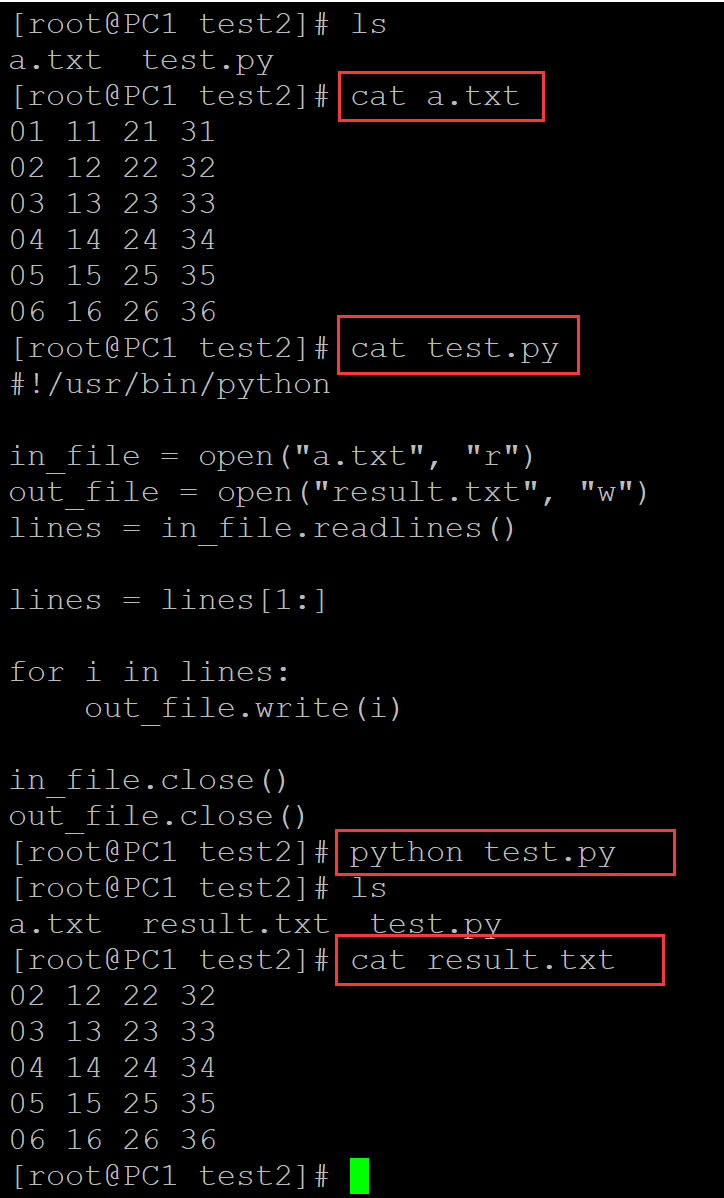
2、删除第3行
[root@PC1 test2]# ls a.txt test.py [root@PC1 test2]# cat a.txt 01 11 21 31 02 12 22 32 03 13 23 33 04 14 24 34 05 15 25 35 06 16 26 36 [root@PC1 test2]# cat test.py #!/usr/bin/python in_file = open("a.txt", "r") out_file = open("result.txt", "w") lines = in_file.readlines() for i in range(0,len(lines)): if i == 2: continue out_file.write(lines[i]) in_file.close() out_file.close() [root@PC1 test2]# python test.py [root@PC1 test2]# ls a.txt result.txt test.py [root@PC1 test2]# cat result.txt 01 11 21 31 02 12 22 32 04 14 24 34 05 15 25 35 06 16 26 36
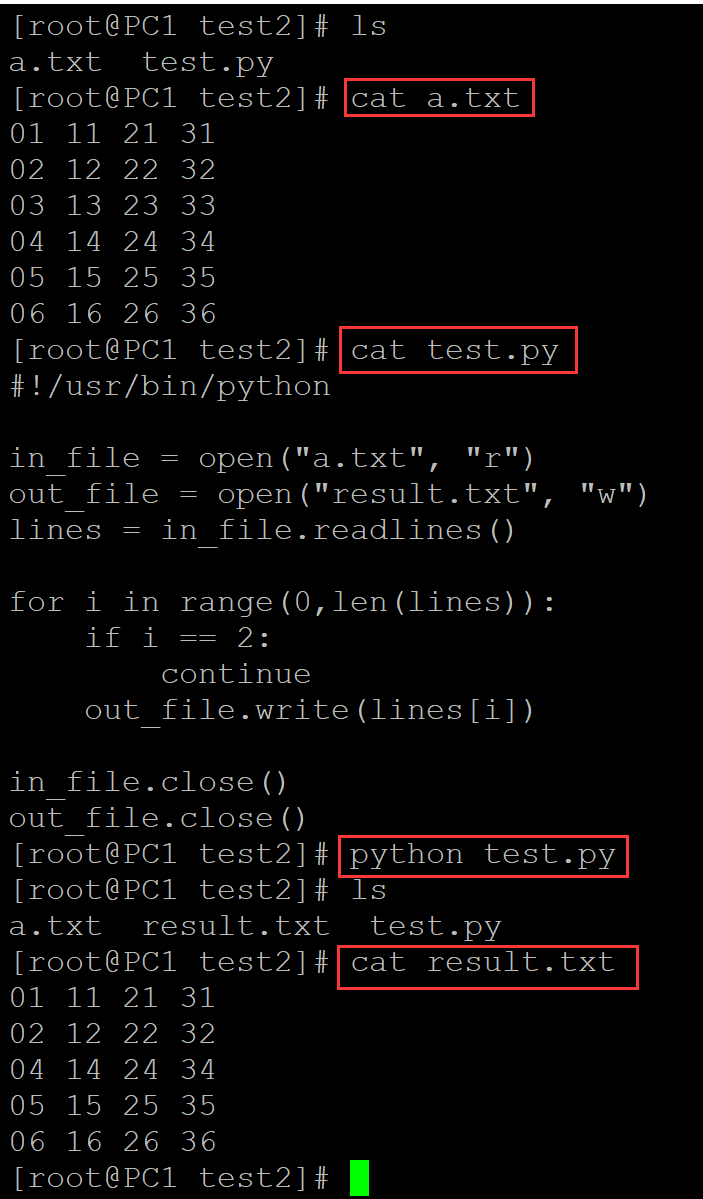
3、删除前三行
[root@PC1 test2]# ls a.txt test.py [root@PC1 test2]# cat a.txt 01 11 21 31 02 12 22 32 03 13 23 33 04 14 24 34 05 15 25 35 06 16 26 36 [root@PC1 test2]# cat test.py #!/usr/bin/python in_file = open("a.txt", "r") out_file = open("result.txt", "w") lines = in_file.readlines() lines = lines[3:] for i in lines: out_file.write(i) in_file.close() out_file.close() [root@PC1 test2]# python test.py [root@PC1 test2]# ls a.txt result.txt test.py [root@PC1 test2]# cat result.txt 04 14 24 34 05 15 25 35 06 16 26 36
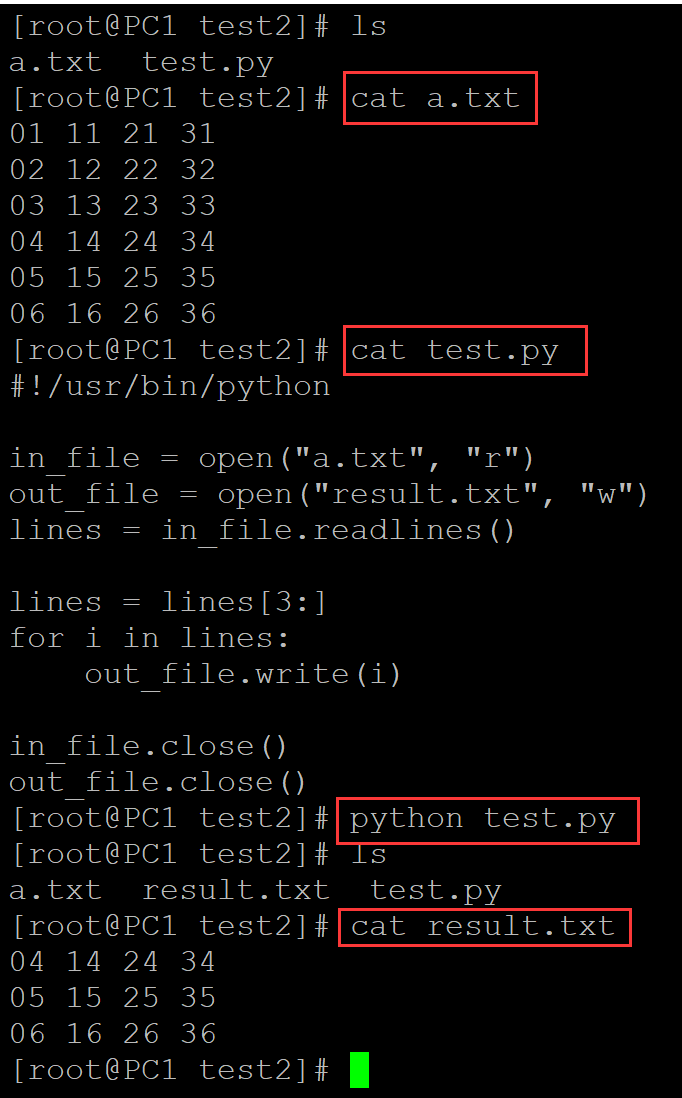
4、删除最后一行
[root@PC1 test2]# ls a.txt test.py [root@PC1 test2]# cat a.txt 01 11 21 31 02 12 22 32 03 13 23 33 04 14 24 34 05 15 25 35 06 16 26 36 [root@PC1 test2]# cat test.py #!/usr/bin/python in_file = open("a.txt", "r") out_file = open("result.txt", "w") lines = in_file.readlines() lines = lines[:len(lines)-1] for i in lines: out_file.write(i) in_file.close() out_file.close() [root@PC1 test2]# python test.py [root@PC1 test2]# ls a.txt result.txt test.py [root@PC1 test2]# cat result.txt 01 11 21 31 02 12 22 32 03 13 23 33 04 14 24 34 05 15 25 35
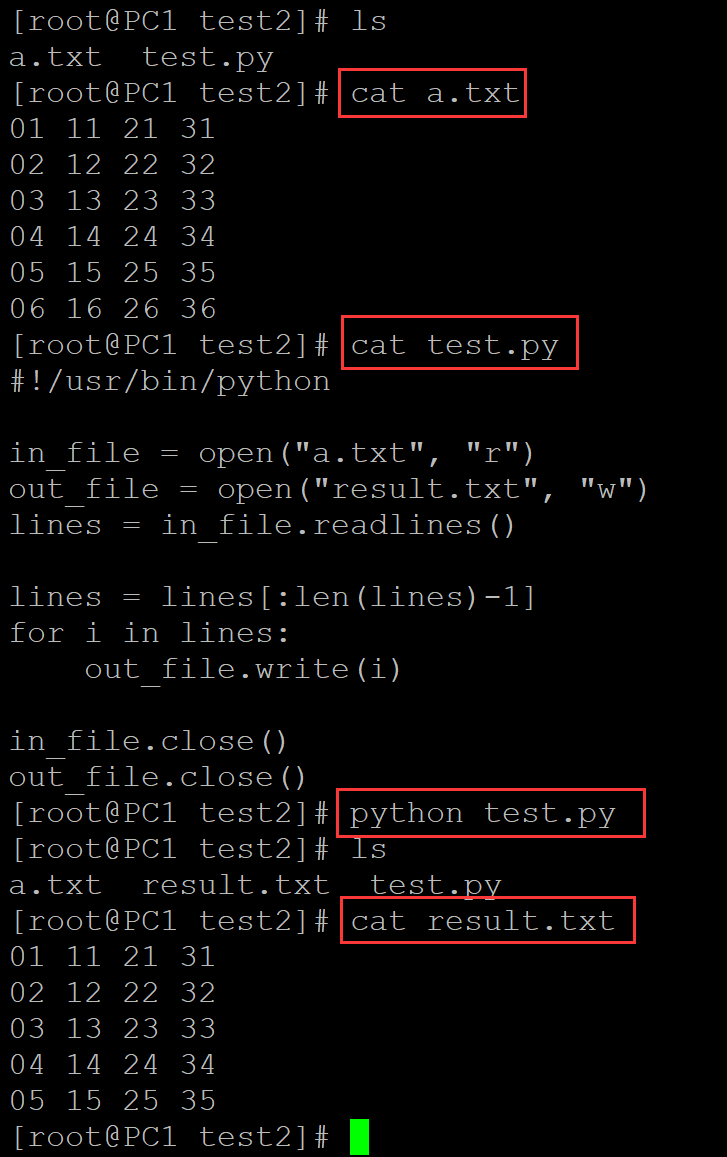
5、删除倒数第2行
[root@PC1 test2]# ls a.txt test.py [root@PC1 test2]# cat a.txt 01 11 21 31 02 12 22 32 03 13 23 33 04 14 24 34 05 15 25 35 06 16 26 36 [root@PC1 test2]# cat test.py #!/usr/bin/python in_file = open("a.txt", "r") out_file = open("result.txt", "w") lines = in_file.readlines() for i in range(0, len(lines)): if i == (len(lines) - 1 - 1): continue out_file.write(lines[i]) in_file.close() out_file.close() [root@PC1 test2]# python test.py [root@PC1 test2]# ls a.txt result.txt test.py [root@PC1 test2]# cat result.txt 01 11 21 31 02 12 22 32 03 13 23 33 04 14 24 34 06 16 26 36
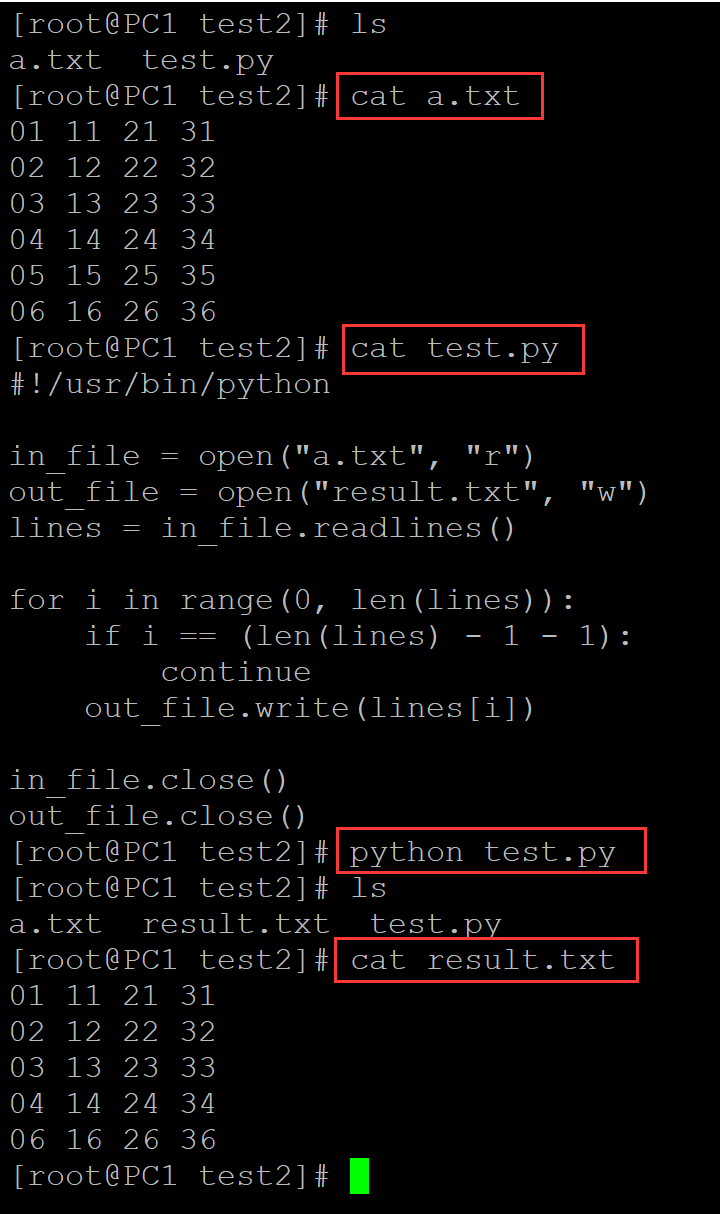
6、删除最后3行
[root@PC1 test2]# ls a.txt test.py [root@PC1 test2]# cat a.txt 01 11 21 31 02 12 22 32 03 13 23 33 04 14 24 34 05 15 25 35 06 16 26 36 [root@PC1 test2]# cat test.py #!/usr/bin/python in_file = open("a.txt", "r") out_file = open("result.txt", "w") lines = in_file.readlines() length = len(lines) - 3 lines = lines[:length] for i in lines: out_file.write(i) in_file.close() out_file.close() [root@PC1 test2]# python test.py [root@PC1 test2]# ls a.txt result.txt test.py [root@PC1 test2]# cat result.txt 01 11 21 31 02 12 22 32 03 13 23 33
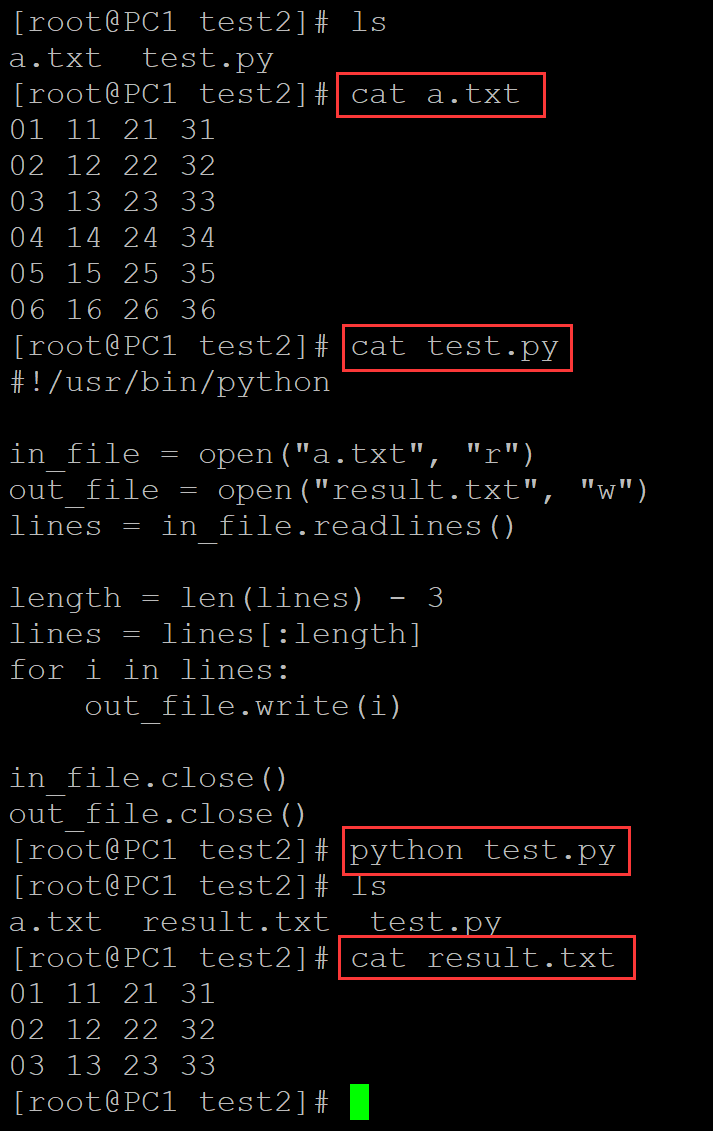






【推荐】国内首个AI IDE,深度理解中文开发场景,立即下载体验Trae
【推荐】编程新体验,更懂你的AI,立即体验豆包MarsCode编程助手
【推荐】抖音旗下AI助手豆包,你的智能百科全书,全免费不限次数
【推荐】轻量又高性能的 SSH 工具 IShell:AI 加持,快人一步
· 震惊!C++程序真的从main开始吗?99%的程序员都答错了
· 【硬核科普】Trae如何「偷看」你的代码?零基础破解AI编程运行原理
· 单元测试从入门到精通
· 上周热点回顾(3.3-3.9)
· winform 绘制太阳,地球,月球 运作规律
2021-06-02 c语言中strncp函数,函数原型、头文件
2021-06-02 c语言中strcpy函数,函数原型、头文件
2021-06-02 c语言 11-6
2021-06-02 c语言 11-5
2021-06-02 c语言 11-4
2021-06-02 c语言中求字符串的长度
2021-06-02 c语言 11-3